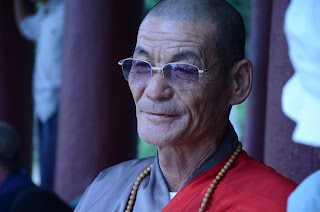Our final full day in the DPRK began with a visit to the Kim Jong-il Gift Museum, which houses ostentatious donations presented to the Dear Leader from Koreans all over the world. This was followed by a hike through the nearby low-lying hills where we subsequently had lunch.
The entire afternoon was taken up by our visit to the newly-reopened Fatherland Liberation War Museum, together with the captured American spy ship USS Pueblo moored on the waterfront close by. The approach to the museum is dominated by the imposing Monument to the Victorious Liberation War, a large white stone park of bronze sculptures depicting various battles of the war. It is dedicated to "the Korean People's Army and Korean people who defeated the US imperialists and its allies during the Fatherland Liberation War."
As in the Mausoleum and the Kim Jong-il Gift Museum, photography was strictly prohibited in the Fatherland Liberation War Museum. The tour begins with a film stating the Korean War was started by the US puppet imperialists in Seoul who invaded the DPRK without the slightest provocation on June 25, 1950. It continues by explaining that thanks to the unparalleled tactical expertise of Marshall Kim Il-sung and his order to change defence into offence, the puppet army was immediately stopped in its tracks. Merely 3 days later on June 28, Seoul had consequently been liberated by the Korean People's Army. (It is indeed true that Seoul was occupied 3 days after the commencement of the war.)
The continuing narrative about the escalation and subsequent conclusion of the conflict in 1953 makes little reference to the role and contribution of the 2.6 million soldiers of the Chinese People's Liberation Army, over 100,000 of whom perished on the battlefield. It completely omits that they effectively turned the tide of the war entirely in the North's favour after Mao's decision to intervene when UN forces were approaching the Yalu River, which forms the border between the DPRK and China. (The fact that the war began when the North invaded the South with a force four times greater in size than the South Korean army is likewise omitted.)
There was very little time for us to observe the numerous displays in details. However, where we were able to, it quickly became apparent that there were countless discrepancies in the accuracy of the exhibits on show. An obvious example would be the photograph reportedly showing US imperialists attacking the DPRK, which in actual fact was clearly an image of the Desert Rats from the British Army fighting Rommel in Africa during World War Two.
Following our tour of the museum, we were shown a selection of dilapidated US weaponry captured during the Korean conflict, but the real highlight proved to be a visit to the USS Pueblo, a ship which has been held by the DPRK since its capture in January 1968.
The ship was impounded off the East Coast of North Korea several days after the failed assassination attempt of South Korean president Park Chung-hee by an elite unit of the Korean People's Army. With tensions running particularly high on the peninsula, the crew of the Pueblo were taken prisoner and charged with spying, before they were eventually released 11 months later.
At the bottom of this page, you can hear about the incident as documented by the North Koreans in the film we were shown while touring the ship. It is fascinating to contrast this with the BBC World Servie Witness broadcast, which tells the story from a completely different perspective.
The museum, monument and ship all stand in the shadow of the infamous Ryugyong Hotel, a 330 metre (1,080 foot) high structure, which was originally scheduled to open in June 1989. The exterior was finally completed in July 2011 but interior work appears to have stalled yet again. No provisional date has as yet been announced when the hotel is officially scheduled to open.
The Kim Jong-il Gift Museum
A Buddhist monk in front of a small temple outside of Pyongyang
A Pyongyang apartment block
Monument to the Victorious Fatherland Liberation War
Monument to the Victorious Fatherland Liberation War
Our wonderful guide Song
Monument to the Victorious Fatherland Liberation War
Monument to the Victorious Fatherland Liberation War
Monument to the Victorious Fatherland Liberation War
Monument to the Victorious Fatherland Liberation War
A facade of the Fatherland Liberation War Museum
The top of the Ryugyong Hotel
US weaponry captured during the Fatherland Liberation War
A view of the Pothong riverfront where the USS Pueblo is now moored and displayed as a trophy
Recounting the history of the captured spy ship
On board
On board
Robert manning the ship's machine gun
Confessions of the crew on display
The USS Pueblo, 44 years after its capture
The actual North Korean film which we were shown on board the ship documenting its history from the perspective of the DPRK
For a contrasting BBC Witness documentary on the Pueblo, please click on this link:
The famous photograph of the captured crew published in Time magazine which is referred to in the BBC World Service documentary.





















No comments:
Post a Comment